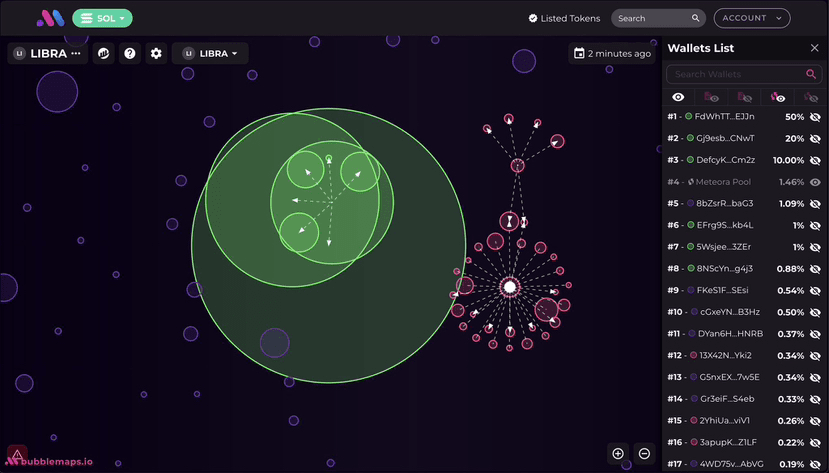Viewing BMT as a standalone 'market asset' is incomprehensible. Its usage scenarios (Intel Desk, advanced feature unlocking, certification and incentives embedded in the ecosystem) and supply structure (cross-chain single total, distribution and unlocking) are variables on the same graph: the more the tool is used, the stronger the token utility; the more transparent the supply, the fewer market 'discount conjectures'.
1. Basic Metrics: Total supply, circulation, trading coverage.
The official and research page metrics align: BMT's total supply is 1 billion, dual-chain format (Solana SPL + BNB Chain BEP-20), with about 25.6% in circulation at TGE; the exchange research page recorded an initial circulation of about 261.57 million (approximately 26.15%) when Binance was listed. As of 2025-08-27 (UTC+8), CMC/exchange pages show BMT's real-time price around $0.068–0.069, with 24h trading volume of about $18–21 million, CMC ranking around #773; aggregation sites have slight variances in 'current circulation', but the consensus is around 'about 410 million' and '1 billion cap'. First pin down the timeline and source, then discuss trends and events for a cleaner logic.
2. Distribution and Unlocking: Clarifying 'who gets how much and how long it takes'.
The official wiki lists the distribution in a table: airdrop ~22.17% (221.7 million), ecology (including Intel Desk) ~21.3% (213.03 million), investors ~19.35% (193.47 million), liquidity ~12.18% (121.8 million), team 9% (90 million), protocol reserve 6%, as well as Binance IDO 4%/HODLer Airdrop 3%/Marketing 3%, etc., combined with cliff periods and linear release. This metric aligns with exchanges/third-party tracking sites; for any rumors about 'entry/unlocking', one can first compare the distribution table and then observe the actual on-chain flows to reduce emotional interpretations.
3. Cross-chain and Single Supply: Not doing 'wrapped tokens', total supply is not split.
BMT's cross-chain mechanism adopts 'cross-chain migration, maintaining a single total supply' design, with the official page stating 'no additional wrapping assets are needed'; exchanges and documentation also indicate 'SPL & BEP-20 dual-stack'. For the supply side, this reduces the risk of 'discrepancies between wrapped token circulation and native circulation'; for the trading side, it reduces 'cross-chain discounts'. When writing market comments, it is advisable to clarify 'which chains are native, whether there are wrapped bridges, and contract addresses' in one go.
4. The demand side is not just a slogan: BMT's 'usage' comes from three leverage points.
1) Intel Desk: Submission/voting/staking are mediated by BMT, giving 'investigation topic priority' to token holders; high-value intelligence contributions can receive incentives, forming a positive feedback loop of 'the more you use, the more valuable it becomes'.
2) Advanced Functionality Unlocking: Historical deep dives, cross-chain associations, advanced analysis components, etc., require holding/using BMT; CMC's interpretation explicitly states 'governance + utility + rewards' as a trio.
3) Ecological Embedding/Certification: Platform parties (browsers/aggregators/wallets) embed Bubblemaps, in some scenarios using BMT as access, ranking or activity proof and incentives. The official 'Integrate' page names several platforms that have integrated (DEXScreener, Pumpfun, Photon, Etherscan), indicating that 'the more people use the graph, the more incentives will surround it'.
5. Activities and Growth: Mapping 'events' to 'curves'.
CMC's 'latest updates' page recorded $150K in BMT activity from 7-30, key position consolidation from 8-19, and evidence collection related to a 'rug-proof' launchpad wallet packaging from 7-29; media reported on 3-18 about the 'surge on Binance's launch day' in short-term markets. The significance of such events lies not in 'excitement', but in being able to connect activity → platform traffic → Intel Desk topics/submission volume, testing whether 'marketing has turned into retention and content'.
6. Users and Traffic: Transforming 'accessible' into 'convertible'.
Bubblemaps discloses 500,000 unique visitors monthly; other platforms/communities mention 'millions of visits per month'. Regardless of the metric, the key point is that it is not 'the closed-door self-entertainment of professional tools', but a product facing retail entry. For BMT, 'accessibility' is the premise, while 'convertibility' into Intel Desk participation, Pro subscriptions, and embedding authorization is where the token utility lands. Creating a closed loop from MAU → BMT usage → Intel Desk proposals/votes → high-value intelligence returns is the flywheel to watch in the second half of 2025.
7. Funds and Equity: The 'tool company' temperament remains unchanged for a decade.
The €3M seed round in September 2023 laid the foundation for the engineering team; only in the first half of 2025, around token issuance, exchange listing, and integration expansion, will the platform's 'commercial storyline' truly accelerate. The exchange research page disclosed the funding composition of equity + multi-round tokens, investor proportions, and IDO details; this verifiable information along the timeline is more substantial than 'second-hand summaries'.
8. Market Metrics and Peer Comparison: Where is BMT's 'valuation pivot'.
Pricing tool-based protocols, the biggest fear is to only look at the 'circulation/FDV/24h volume' trifecta. The pivot of BMT comes from 'the depth and breadth of tool usage':
— Coverage of Embedding (how many top entrances place the graph on the homepage/token page);
— Topic Density (the rhythm of Intel Desk's weekly projects/completions/reviews);
— Practical Hit Rate (the frequency and spread of typical 'PnD/carpet-style' cases being discovered in advance);
— Conversion Rate (MAU → BMT usage/staking → submission/voting → incentive distribution pathway is operational).
External institutions' projections on revenue (based on 500,000 MAU, 3%/5%/10% conversion, $10/$20/$30 ARPU in three scenarios) are merely rough references for valuation; what truly matters are the four verifiable curves mentioned above.
9. Risks and Controversies: Writing the 'blind spots of the tool' upfront.
1) Algorithmic Misfire: Clustering similar ≠ economic relevance; in low liquidity coins, a small number of addresses may also be 'drawn into large clusters'.
2) Entry Dependency: Changes in embedding party strategies, review/legal winds, may cause 'visibility fluctuations' in local markets.
3) Token and Usage Misalignment: If the content density of Intel Desk is insufficient and advanced features are not used, the utility of BMT will weaken to 'activity chip'.
4) Unlocking and Event Impact: The distribution for investors/teams continues to be released linearly over the next few years, requiring 'unlock schedule—trading volume—buy/sell order distribution' to be viewed on one graph to avoid misreading periodic corrections as structural weaknesses.
10. Observation Checklist (suitable for 'weekly cards')
— Supply Side: Distribution unlocking for next week/month, and whether large on-chain flows are concentrated in/out.
— Demand Side: New proposals/votes and completions for Intel Desk, as well as incentives for high-value surveys; advanced functionality BMT usage.
— Ecological Side: New embedding platforms and supporting chains; focus on new connections for Etherscan/DEX aggregators/wallets.
— Market Side: Depth and price spread of major exchanges and trading pairs; smooth changes in real-time prices, trading and rankings on CMC/Coingecko (7 days/30 days).
BMT must clarify that it relies on 'real usage at the tool level'. When 'graph embedding entry' becomes the norm, when 'Intel Desk's topic selection and return distribution' forms compounding, and when 'advanced functionality usage' and 'breadth of ecological embedding' grow steadily, the valuation pivot of the token shifts from 'activity and sentiment' to 'intensity of use'. Placing supply—demand—ecosystem—market on the same graph will naturally yield more stable conclusions.
@Bubblemaps.io #Bubblemaps $BMT